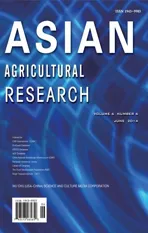Analysis of the Main Factors Influencing Food Production in China Based on Time Series Trend Chart
2014-04-10ShuangjinWANGJianyingLI
Shuangjin WANG,Jianying LI
1.School of Business,Tianjin University of Commerce,Tianjin 300134,China;2.School of Economics,Nankai University,Tianjin 300162,China
The comprehensive food production capacity and food security occupy an important strategic position in China,and attract the close attention of the government and academic circles.The 18th National Congress of the Communist Party of China stated:"we should accelerate the development of modern agriculture,and improve overall agricultural production capacity to ensure national food security and effective supply of major agricultural products"[1].In recent years,China's total food production has shown an increasing trend but the growth is unstable,and in the context of simultaneous development of industrialization,informatization,urbanization and agricultural modernization,it is necessary to scientifically judge the comprehensive food production capacity and development trend in China,conduct in-depth empirical analysis of the factors affecting China's food production,and explore the key factors restricting China's food production,in order to provide a theoretical basis for the development of scientific and rational food production policy.There are numerous factors that affect food production,which can be divided into macro,meso and micro levels.
There are mainly three macro factors as follows:
(i)Institutional innovation,such as the implementation of household contract responsibility system and abolition of agricultural tax and other taxes in the 1980s;
(ii)Policy orientation,such as the minimum food purchase policy since 1998,direct food subsidies and purchasing and storage policy since 2004;
(iii)Advances in science and technology,such as fine variety breeding,efficient cultivation technology promotion,increasing mechanization,and especially the invention of hybrid rice technology,greatly increasing rice yields.
Since the macro factors have the features of great influence and discontinuity,the fluctuation in food production is usually abnormal[2].
The major mes of actors include food crop planting area,food yield per unit area,area affected by disasters,the skills of workers,retail food prices,the state food purchase prices,production costs and income and so on.
The micro factors mainly include various agricultural inputs in the production process,such as land,fertilizer,machinery,labor,and capital.These factors are factors that directly affect food production.
In this paper,we roughly put the above three levels of factors influencing food production into three quantifiable categories:category of material input,category of resources and environment,and category of policy factors.In order to analyze the factors influencing total food production,we use the statistics closely related to food production in the period 1978-2011,combined with the time series trend chart,to carry out the empirical analysis of food production and its influencing factors.Based on the annual sample data on food production in China since the reform and opening up,we select 8 main factors influencing the total food production(growing area,application rate of chemical fertilizer,effective irrigation area,the affected area,total machinery power,food production cost index,food production price index,financial funds for supporting agriculture,farmers and countryside),and put them into categories of material input,resources and environment,and policy factors.Using the factor analysis,we carry out the multi-angle analysis of these typical influencing factors one by one through the time series trend chart.It is found that application rate of chemical fertilizer,the growing area of food crops and drought-affected area become the key factors affecting food production.On this basis,we set forth the corresponding recommenda-tions for improving the comprehensive food production capacity.
1 Category of material input
The material input factors have the most direct impact on food yields,mainly including the application rate of chemical fertilizer per unit area,total agricultural machinery power per unit area and the agricultural technology input per unit area.
In many influencing factors,the contribution of chemical fertilizer is very obvious.From the specific data,the setting of different variables in different periods in different regions and the statistical analysis of model may lead to different results[3].
In order to fully understand the impact of chemical fertilizers on food yield,we conduct analysis from the following aspects:
(i)Analysis from the perspective of the relationship between annual total application rate of chemical fertilizer and total food production.Based on the data of annual food production in the period 1978-2011,among the influencing factors selected by the regression model,chemical fertilizer has the greatest impact on the food production,with the correlation coefficient of 5.05.The chemical fertilizer plays the most prominent role in increasing yields,thereby affecting total food production.
It is found from Fig.1 that since the reform and opening up,the application rate of chemical fertilizer in China has continued to grow ata higher rate,significantly exceeding the growth rate of total food production.The total food production was increased from 304.76 million tons to 571.21million tons in 2011,an increase of 87.43%,while in the same period,the application rate of chemical fertilizer was increased from 8.84million tons to60.27million tons,an increase of5.82 times and an average annual increase of 5.8%.

Fig.1 The food production,application rate of chemical fertilizer and total agricultural machinery power in the period 1978-2011
(ii)Analysis from the perspective of the relationship between the change in application rate of fertilizer per unit area and the change in food production per unit of fertilizer As can be seen from Fig.2,the application rate of fertilizer per unit area in the period 1978-2011 continued to grow rapidly,from 73.3 kg/ha in 1978 to 545.1 kg/ha in 2011,an increase of 6.44 times over the 33-year period,with an average annual growth of6.1%.By contrast,in the period 1978-2011,the food production per unit of chemical fertilizer continued to decline.Compared with 34.48 in 1978,it fell to 9.48 in 2011,and the yield increase effect of chemical fertilizer was reduced to 27.5%at the beginning of the reform and opening up.
Calculations show that in the period 1978-1989,for each additional one percentage point of application rate of chemical fertilizer,the food production would increase by 0.198%,and by converting the current national average at the time,the food production would be increased by 4.5 kg when the chemical fertilizer input was increased by 1 kg;in the period 1990-2000,for each additional one percentage point of application rate of chemical fertilizer,the food production would increase by 0.177%,and by converting the current national average at the time,the food production would be increased by 2.4 kg when the chemical fertilizer input was increased by 1 kg;in the period 2001-2011,the food production was only increased by 2 kg when the chemical fertilizer input was increased by 1 kg.The regression results show that over time,the correlation between food production and chemical fertilizer gradually declines.
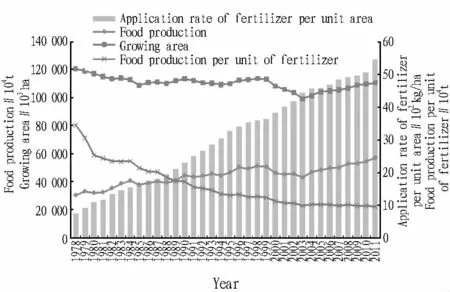
Fig.2 The food production,growing area,application rate of fertilizer per unit area and food production per unit of fertilizer in the period 1978-2011
(iii)Analysis from the perspective of food production increment and fertilizer increment.Fig.3 shows that there are great inter-annual fluctuations in the fertilizer increment and food production increment in China,and the fluctuations in the fertilizer increment and food production increment are basically synchronized.However,the value of fertilizer increment is positive,while the value of food production increment is positive or negative[5].
Fig.3 also shows that in the years with substantial increase in food production,the application rate of chemical fertilizer also rose significantly,such as 1982,1988-1989,1995,2001,2004,2007 and 2011.Meanwhile,in the years with substantial decrease in food production,the increase in the application rate of chemical fertilizer also was not significant,such as 1984-1985,1991,1993,1997,1999-2000,2003[5].
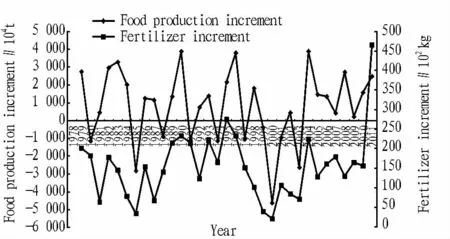
Fig.3 Food production increment and fertilizer increment in the period 1978-2011
Fig.2 shows that the total agricultural machinery power was increased from 117 million kilowatts in 1978 to 977 million kilowatts in 2011,an increase of 7.35 times.China's food production mode achieves the historic leap from human and livestock power to mechanical operation.High degree of mechanization of agriculture has brought an other problem:most of the agricultural machines do not fully play the due role,and especially in the slack season,the agricultural machinery is mostly idle.
The regression model shows thatal though the degree of mechanization of agriculture is related to food production,the impact is not large,because the degree of mechanization mainly affects the production efficiency,such as planting and harvesting speed,and its role in increasing the food yield is not obvious.
2 Category of resources and environment
The food industry is a complex,global collective of diverse businesses that supply much of the food energy consumed by the world population.Only subsistence farmers,those who survive on what they grow,can be considered outside of the scope of the modern food industry.Agriculture is the process of producing food,feeding products,fiber and other desired products by the cultivation of certain plants and the raising of domesticated animals(livestock).
The practice of agriculture is also known as"farming".Scientists,inventors and others devoted to improving farming methods and implements are also said to be engaged in agriculture.More people in the world are involved in agriculture as their primary economic activity than in any other,yet it only accounts for twenty percent of the world's Gross Domestic Product(GDP).A vast global transportation network is required by the food industry in order to connect its numerous parts.These include suppliers,manufacturers,warehousing,retailers and the end consumers.
There are also companies that add vitamins,minerals,and other required necessities during processing to make up for those lost during preparation.Wholesale markets for fresh food products have tended to decline in importance in OECD countries.This also occurred in Latin America and some Asian countries as a result of the growth of supermarkets,which procure directly from farmers or through preferred suppliers,rather than going through markets.
The constant and uninterrupted flow of product from distribution centers to store locations is a critical link in food industry operations.Distribution centers run more efficiently,throughput can be increased,costs can be lowered,and manpower better utilized if the proper steps are taken when setting up a material handling system in aware house.With populations around the world concentrating in urban areas,[4]food buying is increasingly removed from all aspects of food production.
This is a relatively recent development,having taken place mainly over the last50 years.The supermarket is the defining retail element of the food industry.There,tens of thousands of products are gathered in one location,in continuous,year-round supply.Restaurants,cafes,bakeries and mobile trucks also provide opportunities for consumers to purchase food.
Food preparation is another area where the change in recent decades has been dramatic.Today,two food industry sectors are in apparent competition for the retail food dollar.The grocery industry sells fresh and largely raw products for consumers to use as ingredients in home cooking.The food service industry by contrast offers prepared food,either as finished products,or as partially prepared components for final"assembly".Modern food production is defined by sophisticated technologies.These include many areas.Agricultural machinery,originally led by the tractor,has practically eliminated human labor in many areas of production.
Biotechnology is driving much change,in areas as diverse as agrochemicals,plant breeding and food processing.Many other types of technology are also involved,to the point where it is hard to find an area that does not have a direct impact on the food industry.Computer technology is also a central force,with computer networks and specialized software providing the support infrastructure to allow global movement of the myriad components involved.
It mainly includes the growing area of food crops,effective irrigation area and the area affected by disasters.In the above three factors,undoubtedly the growing area of food crops has the greatest impact on total food production.
Based on the time series data of China's food production since the reform and opening up,it can be seen that there is a significant positive correlation between total food production and the growing area of food crops,as shown in Fig.5.Measurement results show that the correlation coefficient between food production and the growing area of food crops is positive(0.352),smaller than the expected value,mainly because in the period 1978-1985,the growing area of food crops was substantially decreased,while the total food production over the same period was significantly increased due to implementation of family contract responsibility system.
If calculating the correlation coefficient between food production and the growing area of food crops by stages,it will be more persuasive.In the period 1985-1990,the correlation coefficient was 0.496;in the period 1991-1998,the correlation coefficient was0.519;in the period 1998-2003,the correlation coefficient was0.553;in the period 2004-2012,the correlation coefficient was 0.586,indicating that the growing area of food crops is one of the main factors affecting total food production.

Fig.4 Food production,effective irrigation area and affected area in the period 1978-2011
Fig.4 describes the changes in the growing area of food crops,effective irrigation area and area affected by disasters in China from 1978 to2011.Fig.4 shows that except1978 and 2003,the growing area of food crops was100million to120million hectares annually,and there was a downward trend.The most significant decrease occurred in the period 1998-2003,when the growing area declined for consecutive 6 years,and there was corresponding decline in food production.
Since2004,the country has attached great importance to food production and food security,strengthened the protection of arable land resources,constantly adjusted and optimized the agricultural structure,so that the growing area of food crops is stably increased and the total food production is also dramatically increased.
The statistics show that the food production is often synchronized with the increase or decrease in the growing area,which can be clearly understood from the perspective of food growing area increment and food production increment,as shown in Fig.5.
Fig.5 shows that in the period 1978-2012,the food production and the growing area showed the consistent change trend,which demonstrates that the changes in the growing area of food crops have a significant impact on food production[6].

Fig.5 The food growing area increment and food production increment in the period 1978-2011
With the increasing contribution rate of agricultural science and technology as well as the adoption of high-quality varieties and advanced cultivation technology,the impact of growing area on food production will be gradually reduced within a certain range.For the effective irrigation area,water conservancy is the lifeblood of the agricultural economy,and the increasing effective irrigation area will undoubtedly play an important role in increasing food production.
As shown in Fig.6,since 1978,the effective irrigation area in China has shown a slow growth trend,and after 2000,the growth rate slowed down significantly.Every year a lot of existing irrigated farmland is occupied due to various factors,so the effective irrigation area is increased slowly.Meanwhile,the effective irrigation area accounts for about half of total sowing area,that is,the role of effective irrigation area in increasing the food yield has been largely reflected in the factor of food growing area,so the regression model excludes the factor of effective irrigation area in this paper.
The area affected by disasters seems to have a significant impact on food production,but in reality it is not the case.As we all know,the natural disasters will directly affect the food production,but the impact of floods and droughts on food production is not the same[7].From the historical data,the impact of the droughts on food yield is greater than the impact of the floods on food yield.The correlation coefficient of the impact of droughts and floods on food production is shown in Table 3.
Table1 shows that the food production change is significantly correlated with droughts,and the area affected by disasters,and the correlation coefficient is-0.613 and-0.596,respectively;correspondingly,the food production change is not significantly correlated with floods,and the area affected by disasters[8].Fig.6 describes the impact of droughts and floods on food production in China during the period 1990-2010.

Fig.6 The impact of drought and flood on food production in the period 1990-2010
Fig.6 reflects that the increase in the area affected by droughts is basically synchronized with the decrease in food production,while the change in the area affected by floods is poorly synchronized with the change in food production.It shows that the impact of droughts and floods on food production varies,and droughts occur in the high frequencies.The droughts in China are concentrated in the northeast and central regions,so strengthening the drought resistance work in these regions is of great significance to China's food production.

Table 1 The correlation coefficient matrix of drought-affected area and flood-affected area
3 Category of policy factors
The fluctuations in China's food production are consistent with the changes in agricultural policy.The food purchase prices,and production material prices are the factors having the greatest impact on food production in the policy system,followed by the proportion of agricultural expenditure to fiscal spending,changes in the organizational system and the government's macro-control[9].
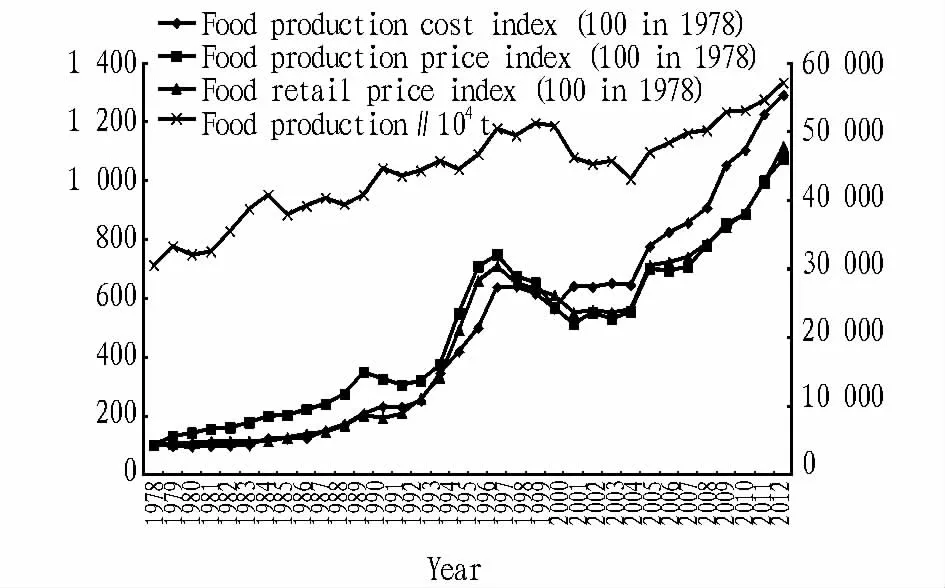
Fig.7 Food production,production cost index,production price index and retail price index in the period 1978-2011
The using amount of agricultural production materials will also have a great impact on food production,and increasing the investment in agricultural production materials will help to increase food production,and also increase the prices of agricultural production materials.Fig.7 shows that in the period 1978-2011,there was a strong correlation among China's food production,production cost index,producer price index and retail price index.
When the prices of agricultural means of production rise or food prices fall,the expected benefits of grain growers will drop,and the rational growers will reduce investment in land,leading to a decline in food production;on the contrary,it will promote food production in the coming year.
As shown in Fig.8,the changes in food production price are basically synchronized with the retail price,but the changes in food production lag behind.It is found that the food production in the current year and food retail price index and production price index in the previous year are greater than the correlation coefficient between the food production and food price index in the current year,because the grain growers often determine the food production input in the current year based on the food price in the previous year.
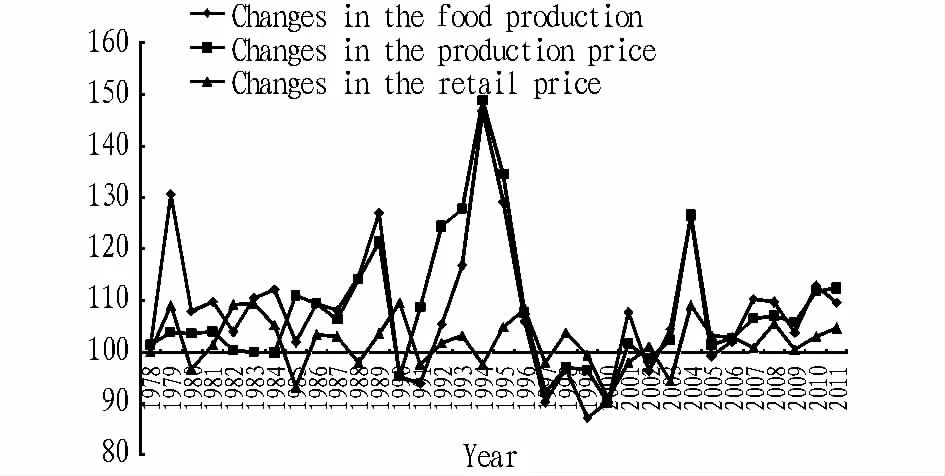
Fig.8 Changes in the food production,production price and retail price in the period 1978-2011
Agricultural expenditure is mainly reflected by the financial funds for supporting agriculture,farmers and countryside.The expenditure will have an impact on the food production,but the impact is not significant.Meanwhile,the role of three categories of scientific and technological expense in increasing food yields is weaker than that of the total financial investment,because the scientific and technological expense will take a longer time to play the role[10].
So it is necessary to reasonably arrange the budget and agricultural inputs,constantly increase financial support for agriculture,optimize the structure of financial support for agriculture,and give full play to the allocation efficiency of financial resources,to enhance potential for agricultural development and provide a lasting impetus for food production.
4 Recommendations
4.1 Continuing to play the role of fertilizer in improving food production and promoting the scientific fertilization techniquesIt is necessary to change the outdated fertilization techniques,accelerate the development and application of efficient and environment-friendly fertilizer,promote the precision fertiliza-tion technology,and use soil testing method to improve the effective utilization of fertilizers,and fundamentally increase food production.
4.2 Further improving the long-term mechanism of arable land protection and mobilizing all levels of government to attach importance to agriculture,increase food production and promote farmers' enthusiasm for growing grainIn the process of industrialization,informatization and urbanization,it is necessary to promote the modernization of agriculture,coordinate the development,utilization and protection of arable land resources,strictly protect agricultural land,especially basic farmland,increase land reclamation and consolidation,and explore the control mechanism for general land use planning.
4.3 Strengthening the agricultural infrastructure construction to improve the comprehensive agricultural production capacityIt is necessary to further strengthen agricultural and rural infrastructure building,and especially accelerate the construction of water conservancy facilities,to improve the overall conditions for food production;continue to improve flood control and drought resistance plans,and strengthen the hydrological monitoring and early warning and forecasting system,to improve the ability to prevent flood and disaster;improve the irrigation and drainage systems,accelerate the transformation of water conservation,and promote the modern rural water conservancy construction.
4.4 Accelerating the development of agricultural science and technology to promote the shift in food production mode
It is necessary to accelerate the agricultural technology innovation and promotion,actively explore the diversified service organizations,and further improve the agricultural science and technology extension network,to constantly increase food yields,reduce unit factor inputs,promote food production to take a resource-saving and environment-friendly track,and achieve a fundamental change in the way of food production.
5 Conclusions
Based on the annual sample data on food production in China since the reform and opening up,we select 8 main factors influencing the total food production(growing area,application rate of chemical fertilizer,effective irrigation area,the affected area,total machinery power,food production cost index,food production price index,financial funds for supporting agriculture,farmers and countryside),and put them into categories of material input,resources and environment,and policy factors.Using the factor analysis,we carry out the multi-angle analysis of these typical influencing factors one by one through the time series trend chart.It is found that application rate of chemical fertilizer,the growing area of food crops and drought-affected area become the key factors affecting food production.
On this basis,we set forth the corresponding recommendations for improving the comprehensive food production capacity.In the process of industrialization,informatization and urbanization,it is necessary to promote the modernization of agriculture,coordinate the development,utilization and protection of arable land resources,strictly protect agricultural land,especially basic farmland,increase land reclamation and consolidation,and explore the control mechanism for general land use planning.
It is necessary to accelerate the agricultural technology innovation and promotion,actively explore the diversified service organizations,and further improve the agricultural science and technology extension network,to constantly increase food yields,reduce unit factor inputs,promote food production to take a resource-saving and environment-friendly track,and achieve a fundamental change in the way of food production.
So it is necessary to reasonably arrange the budget and agricultural inputs,constantly increase financial support for agriculture,optimize the structure of financial support for agriculture,and give full play to the allocation efficiency of financial resources,to enhance potential for agricultural development and provide a lasting impetus for food production.
[1]The 18thCongress of the CPC[R].Xinhua Net,http://www.xinhuanet.com/politics/yj18d/.(in Chinese).
[2]ZHU L,HE XL.The development of Tianjin grain:The status quo and influencing factors[J].Food and Nutrition in China,2009(2):13-14.(in Chinese).
[3]ZHANG LY,PENGH,JIN XC.An analysis of the influence of fertilizer input at different stages on China's grain yield:Based on the panel data from 30 provinces between 1952 and 2006[J].Journal of Agrotechnical Economics,2008(4):85-94.(in Chinese).
[4]GAO F.Theoretical research and empirical analysis on China's grain safety[M].Shanghai:Shanghai People's Publishing House,2005:118-122.(in Chinese).
[5]ZHANG ZW.An empirical analysis on grain yield impact factors in China[J].Journal of Hunan Administration Institute,2011(3):86-90.(in Chinese).
[6]FAN DJ.An empirical analysis on grain yield impact factors and measurement of the contribution rate[J].Journal of Hunnan University of Technology,2011,25(5):55-61.(in Chinese).
[7]XIE YX.Inflation expectation boosts grain price,a study on natural disaster,grain price and inflation[R].China Merchants Securities,2010-8-9.(in Chinese).
[8]MAWJ.Study on over all grain production capability in China[M].Beijing:Science Press,2010:106-107.(in Chinese).
[9]GAOQQ,XINGXF,YAOCJ.Study on grain yield impact factors based on stepwise regression analysis[J].Contemporary Economics,2010(9):145-147.(in Chinese).
[10]PENG KQ,LU XH.Empirical analysis of the relationships between fiscal input in agriculture and grain production capacity in China[J].Journal of Agrotechnical Economics,2010(9):18-29.(in Chinese).
杂志排行
Asian Agricultural Research的其它文章
- The Study of the Operating Performance of Marine Industry in the Blue Economic Zone:An Empirical Analysis Based on DEA and Tobit Model
- Dynamic Mechanism for Development of Urban and Rural Spatial Integration
- The Grow th Path of Agricultural Labor Productivity in Major Grain Producing Areas
- The Research Comment on Organic Food Consumer Behavior
- Research on Factors Influencing Fertilizer Application of Farmer Households in Anhui Province
- Empirical Analysis of Urban Residents' Perceived Climatic Change Risks
